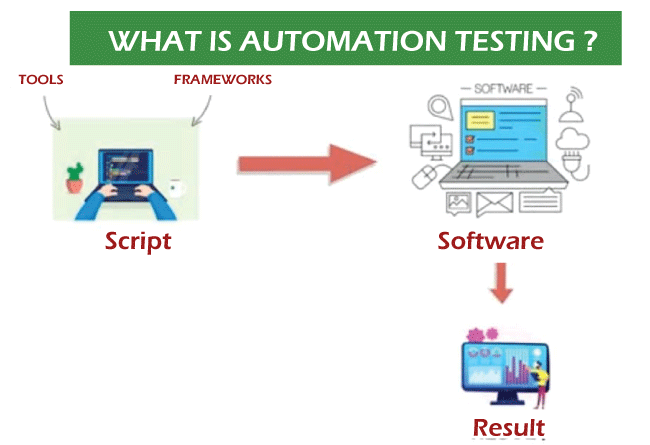Automation Testing Techniques: Ideal Practices for Seamless Combination
Automation Testing Techniques: Ideal Practices for Seamless Combination
Blog Article
From Handbook to Automated Testing: A Comprehensive Guide to Transitioning Smoothly and Properly
In the world of software application testing, the shift from handbook to automated processes has come to be a progressively crucial transition for companies looking for to enhance efficiency and accuracy in their screening methods. As modern technology continues to breakthrough, the requirement for reliable and seamless computerized screening techniques has never ever been extra pressing. The trip from handbook to automated screening is not without its obstacles, but when come close to tactically and with a clear strategy in mind, the benefits can be substantial - automation testing. In this thorough overview, we will certainly explore crucial steps and factors to consider essential for an effective change, from the initial selection of devices to the integration of automation right into existing workflows. Stay tuned to reveal the insights that will certainly help lead the means for a smoother and extra efficient testing procedure.
Benefits of Automated Checking
Automated screening supplies many benefits, improving performance and accuracy in software application advancement processes. One main advantage is the significant reduction in screening time. Automated tests can be run all at once on numerous devices and running systems, significantly speeding up the screening stage contrasted to hand-operated screening. This boosted efficiency permits faster responses on the top quality of the software, making it possible for programmers to identify and attend to issues promptly.
In addition, automated testing makes certain a greater degree of accuracy in detecting issues. Because automated tests adhere to predefined manuscripts, human mistake is reduced, causing even more trustworthy test outcomes. Consistency in screening is additionally boosted, as automated tests perform the same actions specifically each time they are run. This uniformity is vital in ensuring that all performances of the software program are extensively evaluated, lowering the chance of unseen bugs sliding through to manufacturing.
Choosing the Right Devices

To start with, assess your needs and purposes. Recognize the extent of your project, the technologies included, and the ability of your group. This analysis will assist you identify the attributes and abilities you require in your testing tools.
Second of all, think about the compatibility of the devices with your existing systems and processes. Seamless combination with your current software growth lifecycle is vital to make certain a smooth transition to automation.
Additionally, evaluate the scalability and flexibility of the devices. As your testing requires evolve, the devices ought to be able to adapt and fit adjustments efficiently.
Finally, element in the assistance and community around the tools. Durable support and an energetic user area can give useful sources and support when executing automated testing. By very carefully taking into consideration these elements, you can pick the right devices that straighten with your requirements and established the this content phase for a successful shift to automated testing.
Writing Reliable Test Scripts

When crafting examination manuscripts, it is vital to think about the details requirements of the software application being checked and make sure that the manuscripts attend to all critical capabilities. Detailed and clear calling conventions for examination scripts and examination situations can improve readability and maintainability. Furthermore, incorporating error handling mechanisms within the test manuscripts can assist in determining and resolving concerns quickly.
Moreover, arranging test manuscripts into modular components can boost reusability and scalability, reducing redundancy and boosting effectiveness Visit Website in examination manuscript upkeep. Normal reviews and updates to test scripts are important to equal developing software application requirements and functionalities. By complying with these concepts, testers can develop reliable and robust test manuscripts that add substantially to the success of automated screening procedures.
Integrating Automation Into Workflows
Efficient combination of automation devices into existing workflows streamlines processes and enhances efficiency within software program growth cycles. When integrating automation into workflows, it is important to identify repetitive jobs that can be automated to save time and decrease human error. By seamlessly integrating automated testing tools like Selenium or Appium into the software growth lifecycle, groups can attain faster responses on code changes, leading to quicker pest discovery and resolution. This integration permits continual testing throughout the advancement process, making sure that any type of problems are identified early on, leading to higher software program top quality. In addition, automation can be utilized to cause examinations instantly after each code devote, giving prompt recognition and liberating testers to concentrate on more complex situations. Correct combination of automation tools needs collaboration between development, screening, and procedures teams to develop a unified workflow that optimizes effectiveness and performance in delivering premium software.
Making Certain a Smooth Shift
Effectively transitioning to automated testing includes meticulous preparation and careful implementation to take full advantage of and decrease disruptions performance in the software advancement process - automation testing. To guarantee a smooth shift, it is essential to begin by carrying out a complete analysis of the current screening procedures and recognizing locations where automation can bring the most significant benefits. Involving with all stakeholders beforehand at the same time, consisting of designers, testers, and project supervisors, is important for gathering assistance and buy-in for the automation campaign
Interaction is key throughout this transition stage. Clear communication of the objectives, learn this here now benefits, and expectations of automated testing assists to manage any kind of resistance or concerns that may develop. In addition, supplying appropriate training and resources for employee to upskill in automation tools and techniques is crucial for making certain a successful change.

Final Thought
In conclusion, transitioning from handbook to automated screening offers various advantages, including enhanced effectiveness and integrity. By selecting the proper tools, writing reliable test scripts, and incorporating automation perfectly into workflows, organizations can guarantee a smooth and successful transition. It is necessary to embrace automation as a beneficial asset in software program testing procedures to improve total high quality and efficiency.
In the world of software application screening, the shift from manual to automated procedures has actually ended up being a significantly essential shift for organizations seeking to improve effectiveness and accuracy in their screening methods. Automated examinations can be run all at once on multiple gadgets and operating systems, considerably speeding up the screening stage compared to hands-on screening. Uniformity in testing is also boosted, as automated tests carry out the very same actions precisely each time they are run.To make certain the successful implementation of chosen testing tools, the creation of reliable test manuscripts plays a crucial duty in verifying the functionality and performance of automated procedures - automation testing. By adhering to these concepts, testers can produce durable and reliable test manuscripts that contribute dramatically to the success of automated screening processes
Report this page